CMU 10-414/714: Deep Learning Systems (2020) - 深度学习系统 04 Automatic Differentiation
Automatic Differentiation
- hypothesis class: $x \rightarrow h_\theta(x)$, MLP
- loss function(cross-entropy loss): $\ell(x, y) = -h_y(x) + \log \sum_{j=1}^n \exp(h_j(x))$
- optimization method: $\theta := \theta - \alpha \nabla_\theta \ell$
机器学习/深度学习是否就是在学习参数集合 $\theta$?
除了 SGD 随机梯度下降,还有 Adam 等优化方法
计算 gradient 是一个很复杂的问题,但是现在有自动微分
Numerical differentiation
$$ \frac{\partial f(\theta)}{\partial \theta_i} = \lim_{\epsilon \to 0} \frac{f(\theta + \epsilon e_i) - f(\theta)}{\epsilon} \
\frac{\partial f(\theta)}{\partial \theta_i} \approx \frac{f(\theta + \epsilon e_i) - f(\theta - \epsilon e_i)}{2\epsilon} + o(\epsilon^2) $$
numerical error, less efficient to compute
一般用来做 checking?
Numerical gradient checking
$$ \frac{\partial f(\theta)}{\partial \theta_i} \approx \frac{f(\theta + \epsilon \delta) - f(\theta - \epsilon \delta)}{2\epsilon} $$
检查 auto differentiation algo 是否正确
Symbolic differentiation
$$ \frac{\partial (f(\theta) + g(\theta))}{\partial \theta} = \frac{\partial f}{\partial \theta} + \frac{\partial g}{\partial \theta} $$
$$ \frac{\partial (f(\theta) g(\theta))}{\partial \theta} = g(\theta) \frac{\partial f}{\partial \theta} + f(\theta) \frac{\partial g}{\partial \theta} $$
$$ \frac{\partial f(g(\theta))}{\partial \theta} = \frac{\partial f(g)}{\partial g(\theta)} \cdot \frac{\partial g(\theta)}{\partial \theta} $$
回顾偏微分法则
wasted computation:
$$ f(\theta) = \prod_{i=1}^n \theta_i $$
为了避免冗余,现代机器学习和计算工具使用了自动微分(Automatic Differentiation)
这个函数求偏导,会有很多重复的乘积,可以用自动微分和计算图缓存中间结果
Computational graph
$$ y = \ln(x_1) + x_1 \cdot x_2 - \sin(x_2) $$
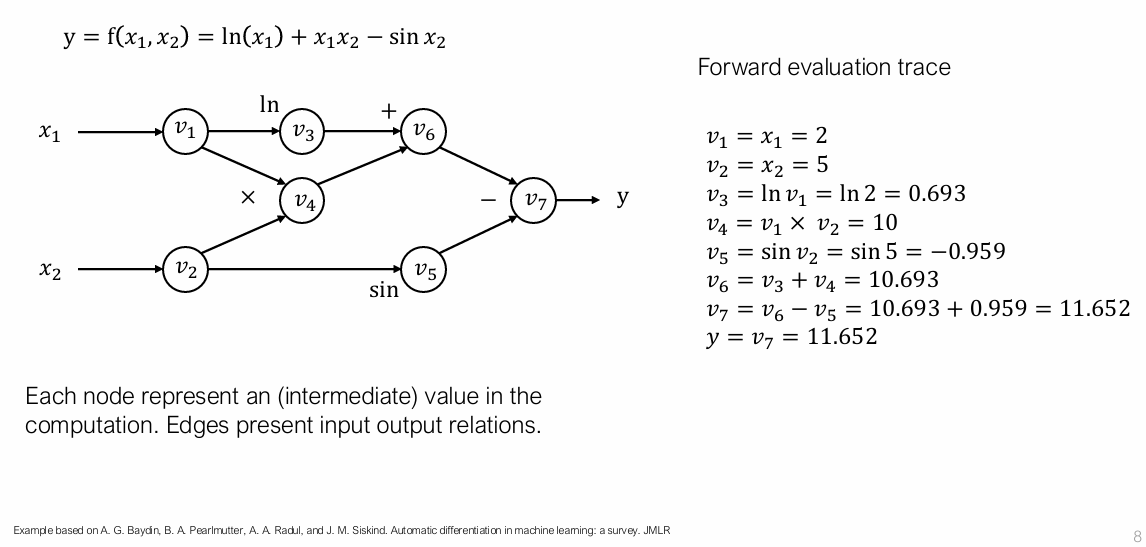
中间结果
Forward mode automatic differentiation (AD)
it automatically propagates gradients through a computational graph based on the mathematical operations involved.
不需要手动计算梯度 计算了很多中间值
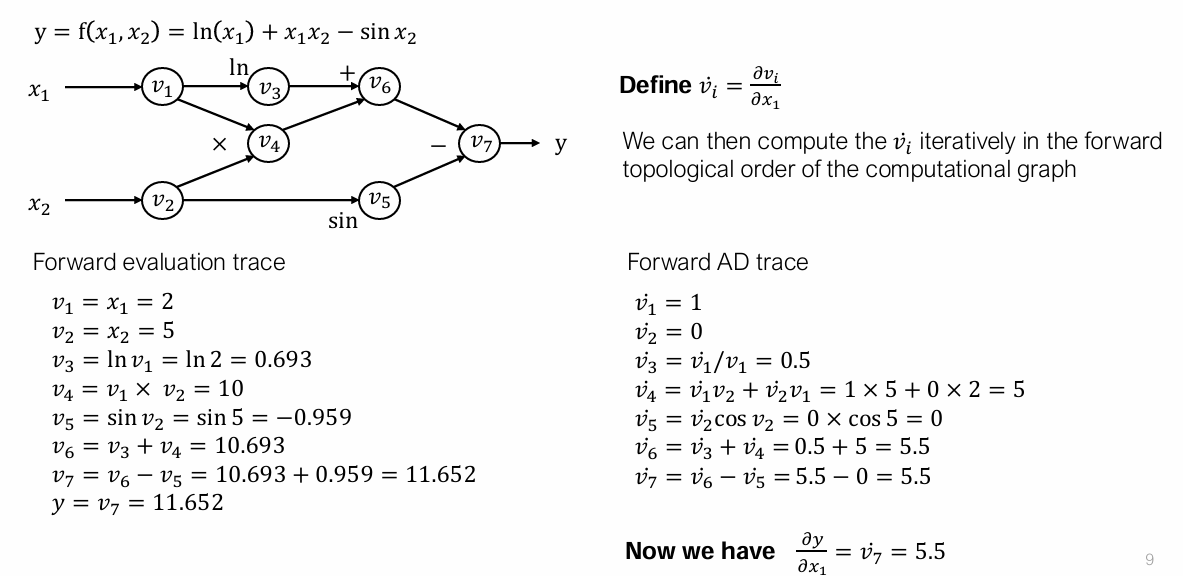
Limitation of forward mode AD
对于函数 $f: \mathbb{R}^n \to \mathbb{R}^k$ ,前向模式自动微分需要 n 次传递 来计算输出对所有 n 个输入变量的梯度。
也就是说,对于每个输入变量 $(x_1, x_2, \ldots, x_n )$,需要单独进行一次计算,以追踪输出随着该输入的变化。
在大多数情况下,当 $k = 1$ (标量输出,例如机器学习中的损失函数)且 $n$ 很大时(如神经网络的权重数量庞大),前向模式会显得 计算成本较高且效率低下,因为它的计算成本随着输入数量 $n$ 的增加线性增长。
We mostly care about the cases where $k = 1$ and large $n$ .
In order to resolve the problem efficiently, we need to use another kind of AD
Reverse mode automatic differentiation(AD)
Adjoint: $\bar{v}_i = \frac{\partial y}{\partial v_i}$
每个变量的导数,但是反向计算
Reverse Mode 一次反向传递即可计算出 标量输出对所有输入的梯度,适用于 $f: \mathbb{R}^n \to \mathbb{R}^1$ 的情况(例如机器学习中的损失函数)。
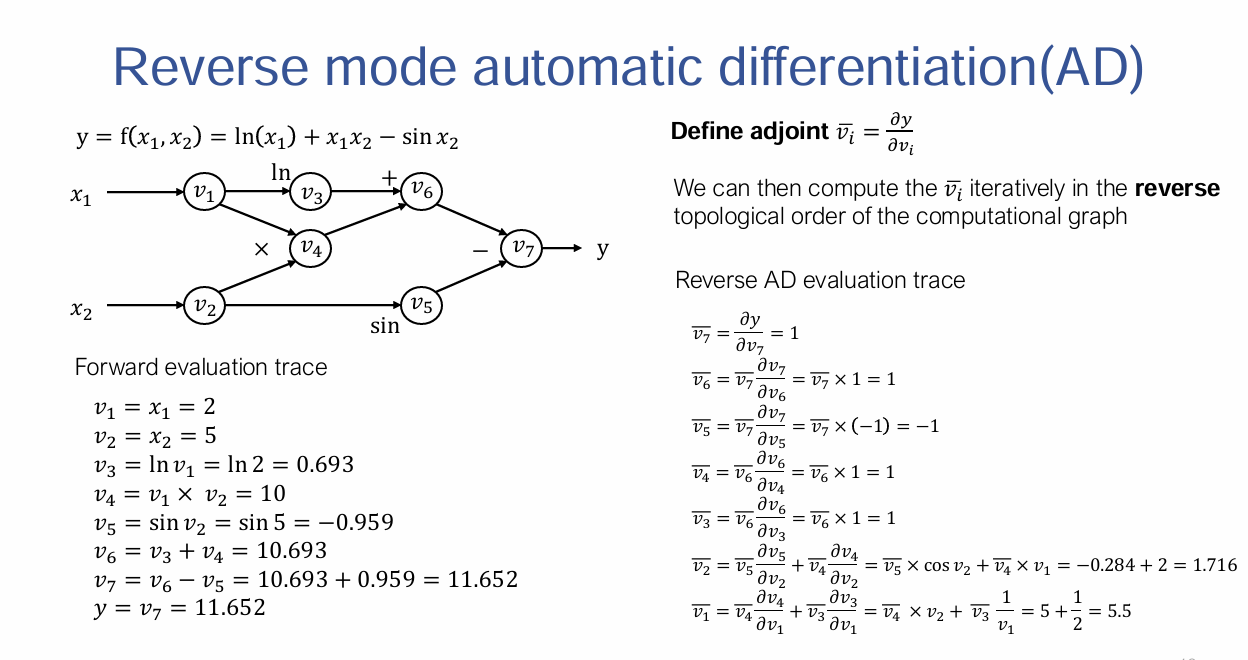
Derivation for the multiple pathway case
multiple pathways

$$ v_1 \
y = f(v_2, v_3) \
\frac{\partial y}{\partial v_1} = \frac{\partial f(v_2, v_3)}{\partial v_2} \cdot \frac{\partial v_2}{\partial v_1} + \frac{\partial f(v_2, v_3)}{\partial v_3} \cdot \frac{\partial v_3}{\partial v_1} $$
partial adjoint: $v_i \rightarrow v_j = \bar{v}_j \cdot \frac{\partial v_j}{\partial v_i}$
$$ \bar{v}i = \sum{j \in \text{next}(i)} v_i \rightarrow v_j $$
We can compute partial adjoints separately then sum them together
自动微分(automatic differentiation)的背景下,针对多路径计算场景的偏导数的推导
用于表示 Reverse AD 算法
Reverse AD algorithm
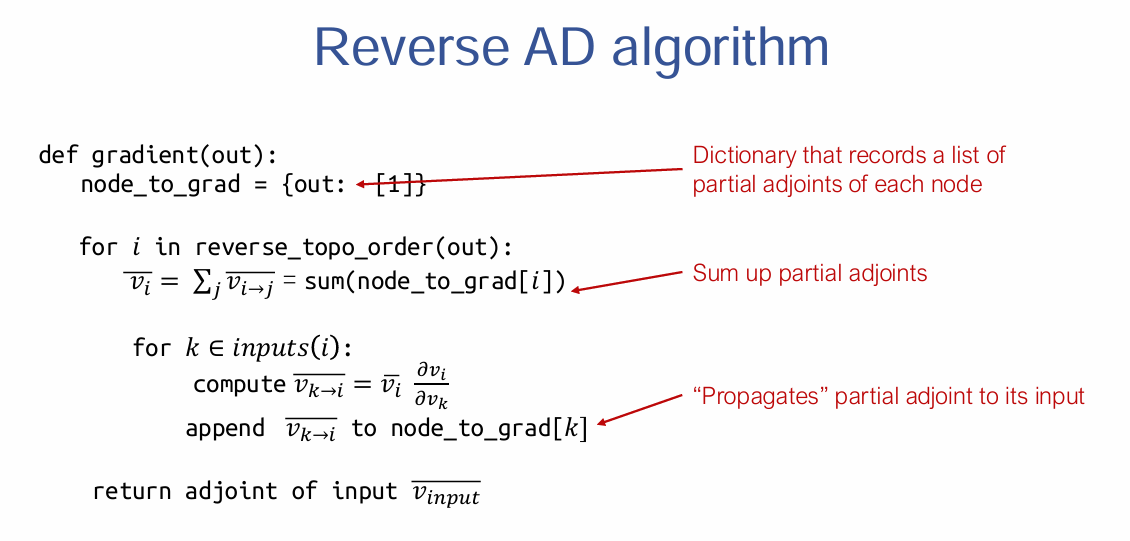
node_to_grad记录 partial adjoint 用于缓存
Reverse mode AD by extending computational graph
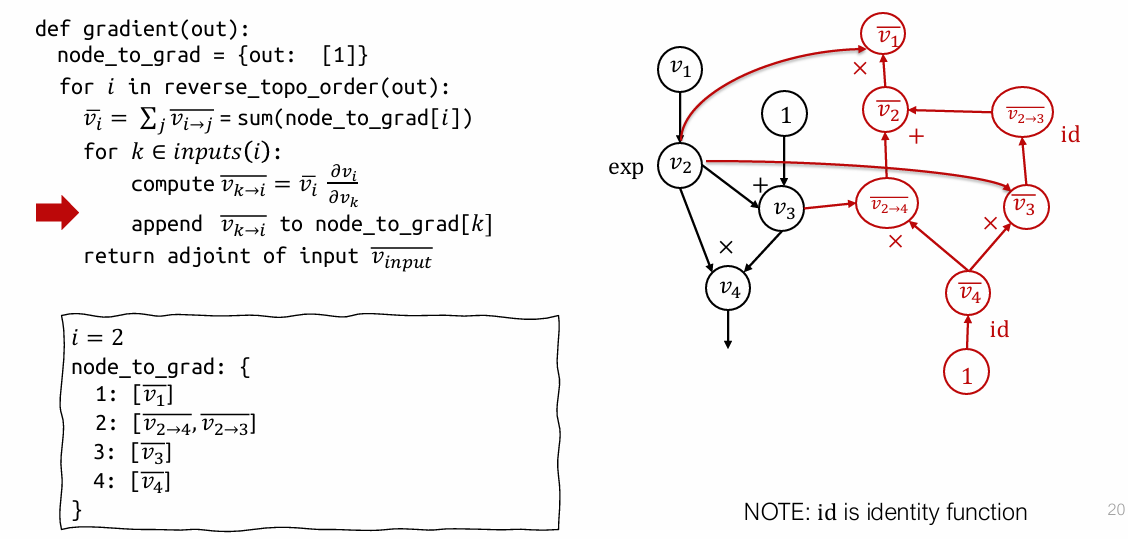
computational graph 拓展
Reverse mode AD vs Backprop
Backprop
- Run backward operations the same forward graph
- Used in first generation deep learning frameworks (caffe, cuda-convnet)
Reverse mode AD by extending computational graph
- Construct separate graph nodes for adjoints
- Used by modern deep learning frameworks
所以 reverse mode AD 自动微分就是缓存了一些其中的结果,用 adjoints 来表示
每次计算就不需要完全重新计算梯度、扩展的图
Reverse mode AD on Tensors
Define adjoint for tensor values
$$ \bar{Z} = \frac{\partial y}{\partial Z} = \begin{bmatrix} \frac{\partial y}{\partial Z_{1,1}} & \cdots & \frac{\partial y}{\partial Z_{1,n}} \ \vdots & \ddots & \vdots \ \frac{\partial y}{\partial Z_{m,1}} & \cdots & \frac{\partial y}{\partial Z_{m,n}} \end{bmatrix} $$
Tensor 计算,reverse mode AD 的向量表达
下一张将讨论实现
pros/cons of backprop and reverse mode AD:
Handling gradient of gradient
The result of reverse mode AD is still a computational graph
We can extend that graph further by composing more operations and run reverse mode AD again on the gradient
Reverse mode AD on data structures
Key take away: Define “adjoint value” usually in the same data type as the forward value and adjoint propagation rule. Then the sample algorithm works